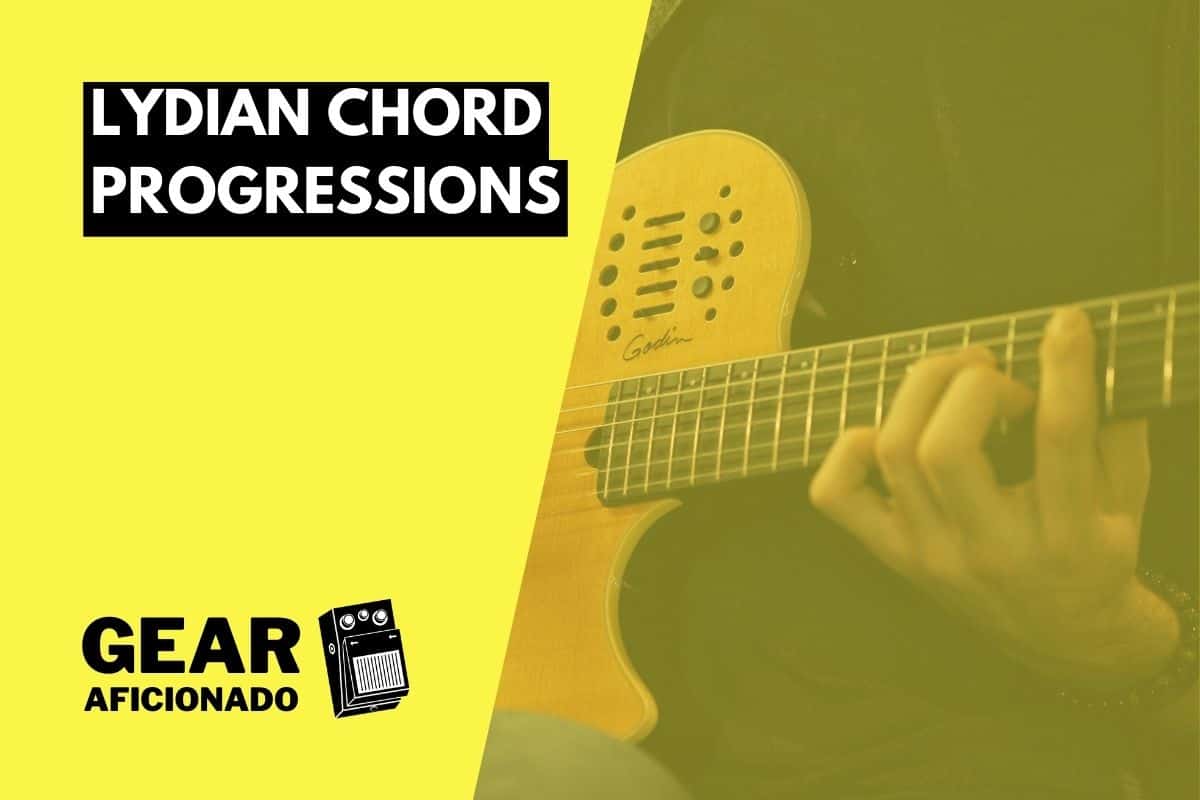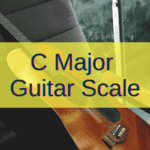Perhaps, the best way to describe the Lydian Mode is to say that it’s pleasantly strange. Yes, it feels like every time you write a tune with this mode or play a song that was written using this mode you get slightly uncomfortable because there are some odd sounds, but it also has that major-scale soothing effect.
But beyond what it can produce sonically, what is the Lydian Mode?
Read on, because you’re about to learn not only what the Lydian Mode is, but also how to use it to take your compositions to the next level.
Are you ready? Let’s do this!
What is the Lydian Mode?
The Lydian Mode is a seven-tone major musical scale with a raised fourth. Wait, what? Let me go slower: The Lydian Mode can be represented as the C Major scale with the fourth note raised by a semi-tone. In other words, we would be talking about a C Major scale with an F# as the fourth note.
This fourth note being raised by a semi-tone gives us a specific formula that can be a great way to put together the Lydian Mode in any key.
| C Lydian Mode | ||||||
| I | II | III | IV | V | VI | VII |
| C | D | E | F# | G | A | B |
| W | W | W | H | W | W | H |
If we forget about the notes for a moment and concentrate on the last row of the table, we can clearly see the formula that the Lydian mode employs. The W stands for a whole tone and the H for half-a-tone.
Therefore, if you use the same formula, you can construct your own version of this mode in any key if you respect the intervals in the last row.
For example, these are the D Lydian and E Lydian modes.
| D Lydian Mode | ||||||
| I | II | III | IV | V | VI | VII |
| D | E | F# | G# | A | B | C# |
| W | W | W | H | W | W | H |
| E Lydian Mode | ||||||
| I | II | III | IV | V | VI | VII |
| E | F# | G# | A# | B | C# | D# |
| W | W | W | H | W | W | H |
Now that we’ve established what the formula is for this mode, we can use the same formula to construct the mode in any key we need to.
These are the Chords
We have constructed the C Lydian mode but from a note perspective. We can’t use notes to build chord progressions, we need to use chords. But what are the chords in the Lydian mode? Well, just like it happened with notes, chords follow a formula. This formula will remain the same regardless of the key we choose to build our Lydian mode on.
The formula is the following:
| Lydian Mode | ||||||
| I | II | III | IV | V | VI | VII |
| Major | Major | Minor | Diminished | Major | Minor | Minor |
Now, if we pour, let’s say, the notes of our C Lydian mode into that formula, what we get is the C Lydian Mode chords in all their splendor:
Likewise, if we pour D and E Lydian inside this mold, what we get are the chords for the Lydian Mode in those two keys:
| D Lydian Mode | ||||||
| I | II | III | IV | V | VI | VII |
| Major | Major | Minor | Diminished | Major | Minor | Minor |
| D | E | F#m | G#° | A | Bm | C#m |
| W | W | W | H | W | W | H |
| E Lydian Mode | ||||||
| I | II | III | IV | V | VI | VII |
| Major | Major | Minor | Diminished | Major | Minor | Minor |
| E | F# | G#m | A#° | B | C#m | D#m |
| W | W | W | H | W | W | H |
Making the Most out of that Fourth Note
Maybe you noticed it already, the fourth note of the Lydian Mode is what gives it the uniqueness in its sound. Therefore, the more you can use and stress that note, the more the progression will sound like a Lydian progression.
That being said, the fourth chord in the Lydian Mode is a diminished chord and most people run away as far as they can from that kind of chord because they feel diminished chords are hard to combine with other types of chords like minor, major, and seventh chords.
But worry not, because we’re not afraid of diminished chords and we will help you use them in your music.
Diminished Triad
To create a naturally diminished chord, what you need to put together is a diminished triad. For these chords, what you need to do is stack up two minor thirds starting from your root note.
Stack two minor thirds? Do I need a motorized forklift to do that? Well, not exactly, what you need is to use the following rule:
1 – b3 – b5
For example, if we were to create our F#° chord, we would have to put together that formula with the notes in the scale.
F# – A – C
Once we put together the formula, we need to find the best place in the fretboard to use it and come up with the right-sounding chord for our composition.
Here are three cool examples of F#° chords around the fretboard that can serve as an inspiration.



Diminished Seventh
Now that you know how to put together a diminished chord, let’s try turning that same chord into a diminished seventh chord to add even more tension to the mix. Remember that we’re in the Lydian Mode, a mode that sounds unique and owes much of that to the diminished chord that’s in the fourth position.
So, what happens if we can add some steroids to that given tension and uniqueness? You guessed it, you can transform it into your songwriter trick up your sleeve.
But let’s slow down and take a look at the formula we’ll use to put together this diminished seventh chord.
1 – b3 – b5 – bb7
Yes, you read it correctly, and I didn’t make any spelling mistakes; the seventh note is a double flat. That double flat means you’re going a whole step down. So, if you were to write it without the flats, you could just write 1 – b3 – b5 – 6.
But let’s translate that to our F# chord and see what the F#°7 chord looks like:
F# – A – C – Eb
Now, let me tell you about a very, very cool fact about every diminished seventh chord you construct: it repeats three frets away from where you are. Yes, the same notes repeat in a different order to give you the same chord just three frets away. This way, you can escalate the entire fretboard repeating that one chord and find it just a stone-throw away in a different voicing.
Let’s see a demonstration of this:
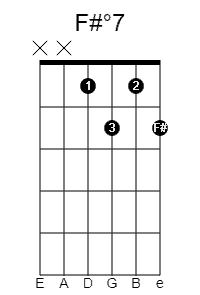
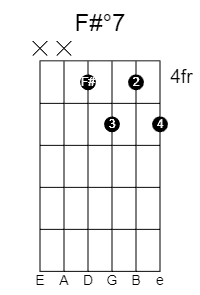
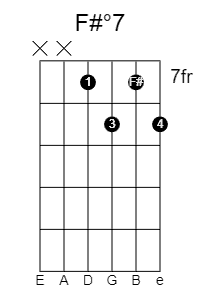
How to Use Diminished Chords in Your Music
The first use is, perhaps, its most famous: as a passing chord. As a passing chord, you can use the diminished chord to move from one chord to another gaining tension in the way. Moreover, you can do that by adding the seventh note and taking tension to its highest.
For example, you can have a C – C#°7 – D progression and use those extra notes to make the D chord sound exactly like home. Furthermore, if you want to take this into the Lydian Mode, try playing Em – F#°7 – G7 – C and you’ll be gathering up so much tension that it will make the listener beg for resolution to the tonic.
Another great use of diminished chords is to pivot from key to key by using that cool repetition of chords with rearranged notes we just saw. For example, you can use any of the notes in the F#°7 chord to move to another key. The rearrangement of notes in a different voicing allows any of the four notes to be the root of the chord.
For example, you can play the F#°7 chord, F# – A – C – Eb, and move to D. You’d be taking the chord as an A°7 and resolving to E major as A is the fifth degree in the key of E.
Finally, as a third use, you can always employ diminished chords as a means of coloration. For example, in C Lydian, going from Em to F#° to G major (iii – IV° – V) can transform into a great way to call your listener’s attention with an odd-sounding passing chord that’s perfectly well within the key and that acts more as an attention catcher than any other thing.
7 Lydian Chord Progressions
- Imaj7 – II6
- I6 – Imaj7 – I5 – Imaj7
- I9 – II – vii7 – vi7
- I – IV° – ii – V
- I – bVI – I – V – IV°
- I – V – II
- vi – V – I – II
The Bottom End
The Lydian mode tends to be an outcast in the world of music because of its unique sound and diminished chord in the fourth position. This chord makes a huge difference when writing traditional modern music with chord progressions such as the quintessential I – IV – V.
So, learn to use the Lydian mode practicing with these hits and make room for those diminished chords in your own music to engage the wow factor in your audience.
Happy (diminished fourth) playing!

Hello there, my name is Ramiro and I’ve been playing guitar for almost 20 years. I’m obsessed with everything gear-related and I thought it might be worth sharing it. From guitars, pedals, amps, and synths to studio gear and production tips, I hope you find what I post here useful, and I’ll try my best to keep it entertaining also.

